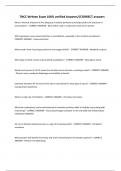TNCC Written Exam 100% verified Answers//CORRECT answers
What is the best measure of the adequacy of cellular perfusion and helps predict the outcome of
resuscitation? - CORRECT ANSWER - Base deficit used in conjunction with serum lactate
Will hypocapnia cause vasoconstriction or vasodilation, especially in the cerebral vasculature? -
CORRECT ANSWER - Vasoconstriction
What results from tissue hypo perfusion and oxygen deficit? - CORRECT ANSWER - Metabolic acidosis
What type of shock results in generalized vasodilation? - CORRECT ANSWER - Neurogenic shock
Spinal cord injuries at C3-C5 causes loss of what nerves function, resulting in what? - CORRECT ANSWER
- Phrenic nerve; paralyzed diaphragm and inability to breath
Extremity elevation AT the level of the heart is beneficial for what type of injury? - CORRECT ANSWER -
Compartment Syndrome
What is a high risk of frostbite? - CORRECT ANSWER - Thrombus formation
What two medications can be administered to maintain perfusion after a frostbite injury along with
rewarming? - CORRECT ANSWER - Tissue plasminogen activator or non steroidal anti-inflammatory
medication (NSAIDS)
An rise in diastolic blood pressures is a sign of increasing what? - CORRECT ANSWER - Peripheral
resistance
What position will benefit the airway and work of breathing for the bariatric patient? - CORRECT
ANSWER - Reverse Trendelenburg
, Which phase of a blast results from flying debris, projectiles, and bomb fragments causing lacerations or
penetrating injuries? - CORRECT ANSWER - Secondary Phase
What phase of a blast results from any explosion-related illness or injury including hyperglycemia,
hypertension, angina, asthma, COPD, or sepsis? - CORRECT ANSWER - Quaternary Phase
What phase of a blast results from individuals being thrown by the blast and impacting walls, ground, or
any hard object? - CORRECT ANSWER - Tertiary Phase
What phase of a blast results from impact of the over and under pressurization wave with body
surfaces. Injuries include blast lung, tympanic membrane rupture, abdominal hemorrhage, globe
rupture, and mild traumatic brain injury? - CORRECT ANSWER - Primary Phase
Signs of what include muscle pain or weakness, dark red or brown urine, general weakness or malaise,
and elevated creatinine kinase levels? - CORRECT ANSWER - Rhabdomyolosis
Signs of what include anxiety, pleuritic chest pain, dyspnea, hypoxemia, hemoptysis, cough, orthopnea,
adventitious lung sounds, decreased lung sounds, jugular vein distention, or hypotension? - CORRECT
ANSWER - Pulmonary Embolus
Signs of what include headache, nausea and vomiting, amnesia, behavioral changes, altered level of
consciousness? - CORRECT ANSWER - Increased intracranial pressure
Signs of what include asymmetric pupillary reactivity, unilateral dilation, widening pulse pressure,
abnormal motor posturing, bradycardia, and decreased respiratory effort? - CORRECT ANSWER - Late
signs of increased ICP with Herniation Syndrome
What is caused by the tear of the bridging veins or middle meningeal artery? - CORRECT ANSWER -
Subdural and Epidural Hematoma





